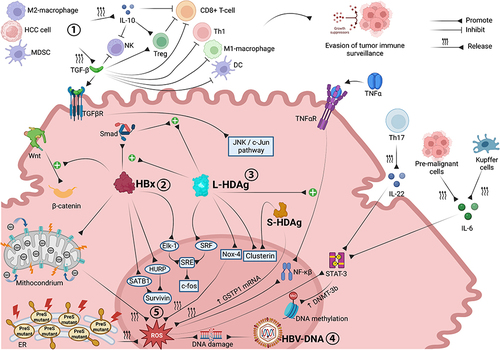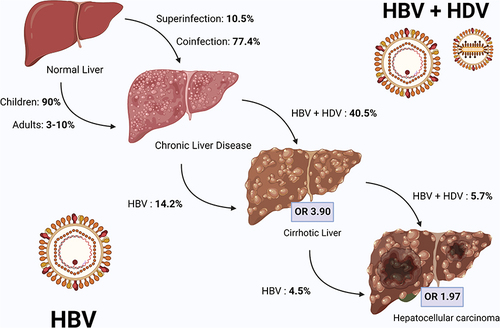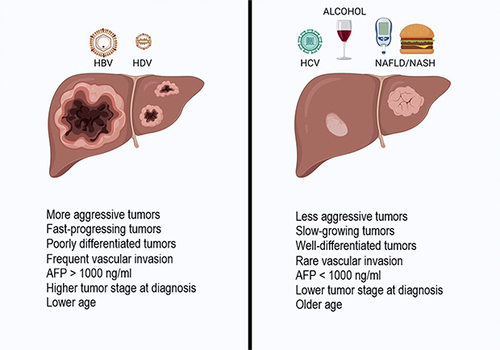Figures & data
Figure 1 Molecular interactions and oncogenic mechanisms occurring in the HCC microenvironment associated with chronic HBV-HDV infection. Both immune cell impairment and stimulation of pro-oncogenic intracellular signaling pathways are involved in CHB- and CDH-driven hepatocarcinogenesis. Through the release of TGF-β and IL-10, M2 macrophages, MDSCs and tumor cells inhibit the antitumor functions of immune effector cells, promoting tumor immune escape. HBx upregulates Wnt/β-catenin signaling and promotes survivin protein synthesis, supporting tumor cell proliferation and preventing apoptosis. Synergistically, L-HDAg and HBx trigger the JNK/c-Jun and SRE/c-fos cascades, both of which are involved in cancer cell growth, proliferation and survival. The integration of HBV-DNA into the host genome and the overproduction of ROS, triggered by HBx, L-HDAg and S-HDAg, promote DNA damage and genomic instability. ROS also promote cancer cell survival, angiogenesis and invasiveness through upregulation of the NF-ĸB pathway, which is also stimulated by L-HDAg in a TNFα-dependent manner, and STAT-3 signaling, which is further activated by Th17 (via IL-22), pre-malignant cells and Kupffer cells (via IL-6). Image created with Biorender.com.

Table 1 Estimated Prevalence of HDV Infection in HBsAg-Positive General Population and HDV Genotypes Distribution by Country
Figure 2 Natural history of HBV and HBV/HDV infected patients. Chronic HBV infection occurs in 90% of infected children and up to 10% of infected adults, while HDV superinfection orcoinfection lead to chronic disease in 10% and 77% of exposed patients, respectively. Compared with HBV mono-infection, HDV/HBV coinfection more frequently leads to liver cirrhosis (OR 3.84), and in a shorter time. The risk of HCC development is increased in both HBV mono-infection and HBV/HDV coinfection (OR 1.66). Image created with Biorender.com.

Figure 3 HCC clinical features at diagnosis in HBV/HDV patients and other aetiologies of liver disease. HBV/HDV-related HCC shows a more aggressive behavior compared with HCC related to other risk factors (such as alcohol, NAFLD, HCV, autoimmune diseases, biliary diseases), with a faster growth rate, larger nodule size, higher AFP serum levels, and a more advanced tumor stage. Image created with Biorender.com.

